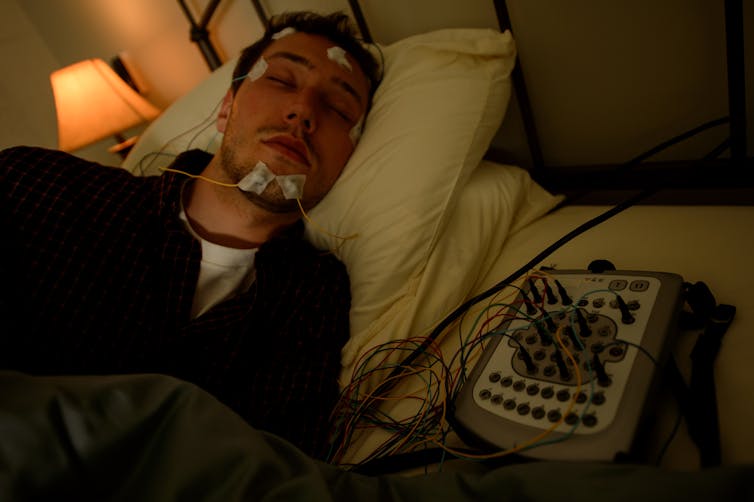Do people dream in color or black and white?
Researchers have found dreams are most likely to occur during the stage of sleep known as rapid eye movement, or REM.

Curious Kids is a series for children of all ages. If you have a question you’d like an expert to answer, send it to curiouskidsus@theconversation.com.
Do we visualize dreams in color or black and white? – Srihan, age 7, West Bengal, India
Dreams are an astonishing state of consciousness. As you sleep, your mind creates fantastic and bizarre stories, rich with visual details – all without any conscious input from you.
Some dreams are boring. Others show you shocking events or magnificent images. I frequently dream of alligators walking upright, wearing sunglasses and yellow T-shirts. Often the alligators are friendly and go on adventures with me, but sometimes they’re aggressive and chase me.
The way the brain operates while you’re dreaming explains why dreams can be so fantastic. A small structure called the amygdala is largely responsible for processing emotional information, and it’s very active while dreaming. In contrast, the brain’s frontal cortex, which helps you plan and strategize, tends to be rather quiet. This pattern explains why dreams can jump from one peculiar scene to the next, with no clear story line. It’s as if you are sailing an emotional wave, without a captain.
Dreams can indeed be emotional and sometimes scary. But dreams can be enjoyable too – maybe you’ve had a dream so delightful you were disappointed to wake up and realize it wasn’t reality.
Are the images in your dreams in vivid color? Perhaps you had a dream about playing Candy Crush and can remember the brightly colored red, purple and yellow candies cascading in your dream.
As a neuroscientist who studies sleep, I can tell you that about 70% to 80% of people report dreaming in color, as opposed to just in shades of black and white. But this estimate may be low, because scientists can’t actually see what a dreamer sees. There’s no sophisticated technology showing them exactly what’s happening in a dreamer’s mind. Instead, they have to rely on what dreamers remember about their dreams.

Studying sleep in the laboratory
To study dreams, researchers ask people to sleep in laboratories, and they simply wake them while they’re dreaming and then ask them what they were just thinking about. It’s pretty rudimentary science, but it works.
How do scientists know when people are dreaming? Although dreams can occur in any sleep stage, research has long shown that dreams are most likely to occur during rapid eye movement sleep, or REM sleep.
Scientists can identify REM by the electrical activity on your scalp and your eye movements. They do this by using an electroencephalogram, which uses several small electrodes placed directly on the scalp to measure brain activity. During REM, the dreamer’s eyes move back and forth repeatedly. This likely means they’re scanning – that is, looking around in their dream.
That’s when dream researchers wake up their participants. Dreams are really tricky to study because they evaporate so quickly. So instead of asking participants to remember a dream – even one they were having a moment ago – we ask them what they were just “thinking.” Dreamers don’t have time to think or reflect, they just respond – before the dream is lost.
Dreams are full-sensory experiences
There seem to be age differences in color dreaming. Older people report far less color in their dreams than younger people. The prevailing explanation for this is based on the media they experienced while young. If the photographs, movies and television you saw as a child were all in black and white, then you are more likely to report more black-and-white dreams than color dreams.
This phenomenon raises some interesting questions. Are people really dreaming in black and white or just remembering their dreams that way after the fact? Was it as common for people to say they dreamed in black and white before these visual media were invented? There wasn’t any focused research that relied on in-the-moment dream reports back before black-and-white photos and movies existed, so we will never know.
Although visual features dominate, you can also hear, smell, taste and feel things in your dreams. So if you dream about visiting Disneyland, you might hear the music from the parade or smell french fries from a food stand.
You may have also wondered whether blind people dream. They do. If a person becomes blind after age 5 or 6, their dreams will contain visual images. However, someone who is congenitally blind, or becomes blind before about age 5, will not have visual images in their dreams. Instead, their dreams contain more information from the other senses.
Remembering your dreams
Some people may say they don’t dream at all. They do, but many people don’t remember their dreams. The vast majority of dreams are forgotten. That’s because when we’re in REM sleep, the hippocampus, the area of the brain responsible for long-term memory, is largely turned off.
Others may remember a dream immediately upon awakening but quickly forget it. That’s because the hippocampus is a bit sluggish and takes some time to wake up, so you’re not able to create a long-term memory right after waking.
Perhaps the biggest question about dreams is whether they mean anything. People have been discussing this since ancient times. Sigmund Freud, the founder of psychoanalysis, called dreams the “royal road to the unconscious.” He believed they had a profound meaning that’s hidden from the dreamer.
But today, scientists agree that dreams do not have any hidden meaning. So while it’s entertaining to think about what your dreams mean, there’s no scientific basis, for example, to think that a dream about your teeth falling out automatically means you’re anxious about a loss.
If you would like to remember your dreams better, simply keep a notepad and pen by your bed and practice writing down your dreams right when you wake. This is the best way to remember the fantastical stories your brain creates for you every night.
Hello, curious kids! Do you have a question you’d like an expert to answer? Ask an adult to send your question to CuriousKidsUS@theconversation.com. Please tell us your name, age and the city where you live.
And since curiosity has no age limit – adults, let us know what you’re wondering, too. We won’t be able to answer every question, but we will do our best.
Kimberly Fenn does not work for, consult, own shares in or receive funding from any company or organization that would benefit from this article, and has disclosed no relevant affiliations beyond their academic appointment.
Read These Next
Polytechnic universities focus on practical, career-oriented skills, offering an alternative to trad
Polytechnic universities try to incorporate skills-based learning into education.
The Ivies can weather the Trump administration’s research cuts – it’s the nation’s public universiti
While headlines focus on Harvard and Columbia, state universities train far more STEM students, power…
The dystopian Pottersville in ‘It’s a Wonderful Life’ is starting to feel less like fiction
Frank Capra’s dark vision of corruption and greed highlights both the dangers of concentrated power…






